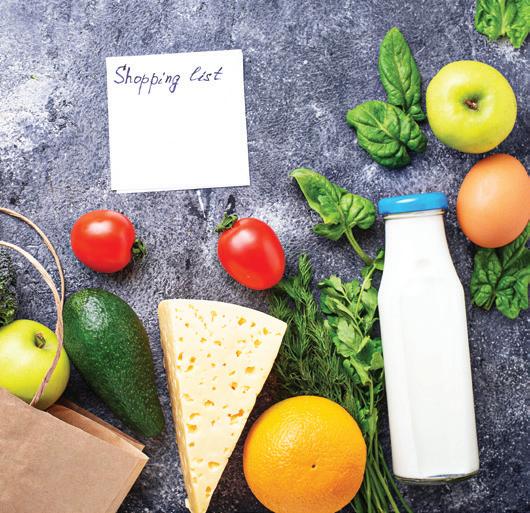
9 minute read
How our food habits are impacting the environment
Food for thought
Lane Cove local Dinh Tran has two passions - food and the environment. This has led her to create a global campaign called the ‘Save Food Movement.’ Words by Jocelyn Biddle.
Advertisement
Dinh Tran says that we have a responsibility to purchase and prepare food more responsibly. Judy Friedlander says that before we buy food, we need to think about its impact on our planet.
The campaign is aimed at making a difference by encouraging people to consciously reduce food waste to protect our environment.
“The ‘Save Food Movement’ is about inspiring people to realise that we can all make a difference,” says Dinh. “And we need to act now – not later.
“For every new enduring food saving habit that we adopt, there will be an amazing positive knock-on effect for our environment.”
Dinh emphasises that we all have a responsibility to purchase and prepare food more responsibly to reduce how much is being thrown out. “As food breaks down in landfill, it produces methane, which is 25 times more lethal than carbon pollution. This is having devastating effects on the environment and the sad truth is that with a bit of planning, this is largely preventable.” A food and travel expert, Dinh is also the founder of www.eattheglobe.com.au - an online community where users can discover and share interesting food stories from around the world.
Dinh said current trends highlight the extent of the food waste issue, both in Australia and globally: • A staggering one third of all food produced around the world is wasted - which is equivalent to 1.3 billion tonnes.
If only 25% of this waste was saved globally, the chronically hungry (870 million people) could be fed. (The Food and
Agricultural Organization of the United Nations (FAO), 2011) • Australians throw out $8 billion worth of edible food every year, which is equivalent to 4 million tonnes. 33% of this is fresh food. (foodwise.com.au) • Australians throw up to 20% of the food they purchase, which equates to over $1,000 worth of food per household every year. (Mintel 2017; foodwise.com.au) • The biggest food wasters are typically 1824 year olds; households with more than $100,000 annual income; and families with children. (foodwise.com.au) • Throwing out food also throws away all the resources used to produce that food. For example, throwing out 1kg of beef wastes the 50,000 litres of water it took to produce that meat. (CSIRO data) Judy Friedlander is the founder of FoodFaith, which runs multi-cultural food events and operates a community garden at Hughes Park in Lane Cove. Judy is also a post-graduate researcher at the Institute for Sustainable Futures at University of Technology Sydney. She says that there is so much that we can all do to help our environment through our food choices.
“Before we buy food, we need to think about its impact on our planet. For example, if we consider the ‘food kilometres’ involved in buying fruit or veges out of season, they are likely to have been flown in - sometimes from overseas - which contributes to greenhouse gases. This is significantly reduced if we choose seasonal produce grown locally.” Judy explains that meat, particularly beef, has the greatest environmental impact of all food groups. “Compared to plant based foods, meat production uses a great deal of water and phosphorous, which is a finite resource. Cattle also produce methane, which contributes significantly to greenhouse gases.” Judy says that reducing the amount of meat we consume is not only one of the most significant steps that we can take to reduce our environmental footprint, but
OZ HARVEST, Australia’s leading food rescue organisation, has started a community awareness program aimed at reducing food waste with a simple 4 step process. 1. LOOK at what you already have in your fridge, pantry and freezer before shopping. 2. BUY what you need to save money, reduce food waste and help the planet. Write a shopping list and don’t be tempted by offers and deals so you only purchase what you need. 3. STORE food correctly to make it last longer. 4. COOK with what you have and apply the ‘use it up’ approach to make food waste a thing of the past in your home.
Source: www.ozharvest.org
it also has associated health and animal welfare benefits.
“From an environmental and health point of view, it’s not about removing meat entirely, but eating less of it, and paying more for the meat that we are consuming.” Judy was involved in the Meat Free Week campaign, founded in 2013, which is designed to get people thinking and talking about meat consumption and production. This awareness campaign motivates action by challenging participants to give up meat for seven days whilst raising funds for Bowel Cancer Australia. By going meat free for one week, the campaign helps people think about how much meat they eat and the impact that eating too much can have. Judy says small steps can make a big impact when it comes to playing our part with environmentally friendly food choices. For example: • Make a shopping list. Buy local. • Have a few meat free days each week and replace with plant based proteins. • Each time you purchase fresh food, think about how you can use it not just once, but two or three times.
• Freeze your leftovers.
• Revisit your mother’s or grandmother’s
recipes which were often more sustainable, incorporating leftovers and different cuts of meat (nose-to-tail). • Grow your own herbs. • Use vegetable scraps for composting or in a worm farm. For more information, see www.foodfaith.com.au
According to research by The Australian Institute, food wastage will take significant government action and all Australians participating before we can turn around this massive issue.
In fact, according to current trends, food wastage volumes are likely to further increase based on two key factors – rising incomes and declining household sizes. At the same time, projections of significant population growth will further exacerbate the problem. “Food consumption generally goes through five stages - Planning, Buying, Storage, Preparation and Usage,” says Dinh. “For every stage, we can all develop new food saving habits and hence save our precious planet.” Dinh is hopeful that once consumers become more aware of the huge impact that throwing out food has on our environment, these new habits will flow through to cafes and restaurants too, as people only order what they can eat, thereby reducing food waste from within the hospitality industry.
To find out more about the ‘Save Food Movement’ and for tips and tricks that you can implement at home, visit
www.eattheglobe.com/sfm
5 STEPS FOR REDUCING FOOD WASTE:
1.PLANNING - 30-50% of food waste occurs at the household level and is the result of poor planning and over-buying. Learning how to create a weekly menu plan and planning ahead is crucial. 2. BUYING - Over-buying is the number one reason why food loss and waste occurs. Most of us buy food we had no intention to purchase before going to the shops. A good tip is to stick to a shopping list. 3. STORAGE - Only buy what you can properly store. Check your fridge and freezer to make sure you have enough space to avoid overcrowding. 4. PREPARATION - How you prepare your food will help minimise food waste. Be aware of correct portion sizes to avoid cooking too much. Be sure you use leftovers promptly to avoid food waste.
5. USE OF FOOD - The last step is the most important. Did you consume the food you purchased or did it become food waste? To help you ensure you eat as much of your purchased food as possible, implement the FIFO (First In, First Out) principle. Place foods closest to expiry at the front of your fridge and pantry.
Food waste is having a devastating impact on the environment. The sad truth is that with a bit of planning, this is largely preventable.

How can you reduce the amount of food you throw out?
Come along to hear Dinh Tran, founder of the Save Food Movement, for her top tips on reducing food waste in your kitchen. Where: FoodFaith Community Garden, Hughes Park, Waterview Drive, Lane Cove When: 9.30 - 11.30am, Sunday 4th November Cost: Free. Bring along any salad ingredients and bread from your fridge As a practical step towards reducing food waste, produce will be harvested from the FoodFaith community garden and all the ingredients gathered from everyone will be combined into a tasty salad, so participants can enjoy a salad sandwich for brunch. Healthy, tasty and satisfying!
For more details, go to: http://bit.ly/savefoodevent

To encourage local residents to reduce food waste, The Village Observer has partnered with the Save Food Movement so that readers can receive a $20 coupon from Woolworths online to use for their next grocery shop.*
SEND AN EMAIL TO: info@eattheglobe.com and include a photo that shows you doing something to save food or reduce food waste. For example, it might be a photo that shows you using up your leftover veges in a recipe, or perhaps your shopping list which is helping you to only buy what you need.
*Vouchers valid till 1st Feb 2019. Full terms/details of coupon will be sent via email.
Volunteers needed for Rotary Fair
Rotary’s biggest fundraiser of the year, the Lane Cove Fair, is happening on Sunday 14th October. They need people keen to help with the BBQ – preparing the rolls, cooking and serving. Or maybe you can help with another task. As little as an hour of your time will be a huge help.
Please sign up at www.lanecovefair.com.au or call Adrienne on 9428 5900.

SIGNALISED PEDESTRIAN CROSSING UNDER REVIEW
In response to ongoing complaints regarding traffic delays as a result of the constant stream of pedestrians accessing the crossing between the Westpac Bank and Lane Cove Plaza on Longueville Road, Council is undertaking further reviews. Surveys to measure vehicle queue lengths were commissioned in June and July 2018. Council will now undertake additional surveys to measure vehicular delays, which will take place over two weeks during the non-holiday period. The queue length survey showed that the impact of pedestrian traffic on vehicular traffic is generally minimal. Morning surveys (on Wednesday and Saturday) showed an average maximum queue length from three to four vehicles. The afternoon surveys show that the average queue length varied from one to five vehicles. In a heavily pedestrianised area such as the Plaza, a queue of three vehicles is generally considered acceptable. Council has discussed the installation of traffic signals at this crossing with Roads and Maritime Services (RMS). RMS has a concern that this location, if signalised, would show lack of compliance with people weaving in and out of the cars instead of waiting for the lights to change. RMS also advised that before installing traffic signals, the site must meet the RMS Traffic Signal Design warrants, so further pedestrian and vehicular counts are required. At the Rosenthal end of the Plaza, Council is continuing to investigate how to improve turning of longer vehicles, potentially by widening the road on the western side. This will involve significant service relocation and design, which Council will investigate in order to improve vehicular safety and access.









